The Telegraph
The first commercial use of electricity was not lighting, but communicating over wires. And it was done with nothing more than batteries, switches and coils.
The word telegraph means writing from a distance and the term was first used in France in the 1790’s to describe an optical network called the Chappe Telegraph. This system used special flags with moveable arms that were placed at the top of towers, six miles apart, and could encode various letters and numbers based on the positions of the arms. Residents of the towers used special telescopes to observe the signals from other towers. This system was so successful that at it’s peak, in 1846, there were over 522 towers covering over 3000 miles across France, Belgium and part of Italy. Messages could be sent from Paris to Northern Italy in about 30 minutes. That’s a 13 hour train ride today, or eight days on foot.
While the Chappe Telegraph was quite successful, it had severe limitations. It was expensive, requiring around 1000 people to operate the towers. It was only available to the throne and it’s agents, and it was only functional in daylight and good weather.
Ever since the discovery of the Leyden jar efforts were made to use electricity to communicate over wires. In 1837 the pieces finally came together for what would be the two dominant commercial systems for electrical telegraphy: the Cooke and Wheatstone system in England, and the Morse system in America. While the Wheatstone system is interesting, the Morse system had a larger impact and is the one I want to focus on.
Morse, Henry and Vale
Samuel Morse was a portrait artist from a wealthy Boston family. While studying art at Yale he also took classes on electricity. He spent time in France as part of his art studies and came across the Chappe system, recognizing the improvement an electrical system could make. On his journey home he had a conversation with another return passenger who had just attended lectures on electromagnetism in Paris. It was on this trip in 1832 that Morse determined to build an electric telegraph.
He took a post as Professor of Literature of the Arts of Design at New York University in 1835 where he had space near the professor of Chemistry, Leonard Gale. Gale was a close personal friend of Joseph Henry. This is important because Henry, a professor of Natural Philosophy first at the Albany Academy in New York and then at Princeton, was one of the leading experts in electromagnetism. In 1831 Henry ran over a mile of wire on the Albany campus to demonstrate to his students that by pressing a switch he could ring a bell over a mile away. Many consider this to be the first telegraph. Morse spoke with Henry on at least two occasions, but never mentioned or gave any credit to Henry for his invention.
In 1837 Morse demonstrated a cumbersome prototype to a group at NYU that included one of his former students, Alfred Vale. Vale’s father and brother owned an iron works in New Jersey where Alfred Vale had learned to be a machinist (his degree at NYU was in Theology). Vale offered his services in exchange for a 25% ownership in the company, to which Morse agreed with the condition that any new inventions created as part of their partnership belonged to Morse.
Vale set up demonstrations at the iron works with two stations connected by 3 miles of wire. The demonstrations with Morse’s original designs weren’t going very well. Vale set out to improve them and by spring of 1838 Morse submitted the patent for what is now known as the Morse Telegraph. It included a transmitter key at either end, a relay connected to a register at either end, as well as a coding system for sending letters, Morse code.
The Morse Telegraph System
To understand how the Morse System works it’s worth looking at how Joseph Henry was able to ring a bell across campus. Just like an electromagnet can be used to flip a switch, it can be used to push a metal armature to strike a bell. The trick is that over long distances there isn’t enough current to drive the armature into the bell, so a relay is used to switch on a more powerful current near the bell.
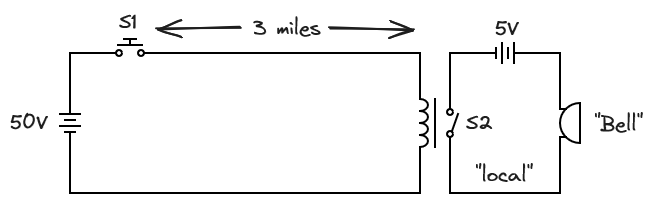
Pushing the button for switch S1 rings the bell by activating the switch S2 of the relay over 3 miles away. The 5V batteries near the bell only need to power the bell on the “local” circuit, while the 50V batteries supply the current from the distance of the button to the bell (the “bell” has an electromagnet and armature not shown). By ringing the bell in patterns someone could send messages over this distance, but how would someone at the bell send messages back?
Sending and receiving messages
The Morse system utilized a sender and a receiver at both ends. The sender, like a push button, was called a key. The receiver was called a register, but for the moment think of it as a bell. How can the circuit above be used to send and receive in either direction? By keeping the line powered on until someone was ready to send. This is done by placing a toggle switch to bypass the key until it’s ready to be used.
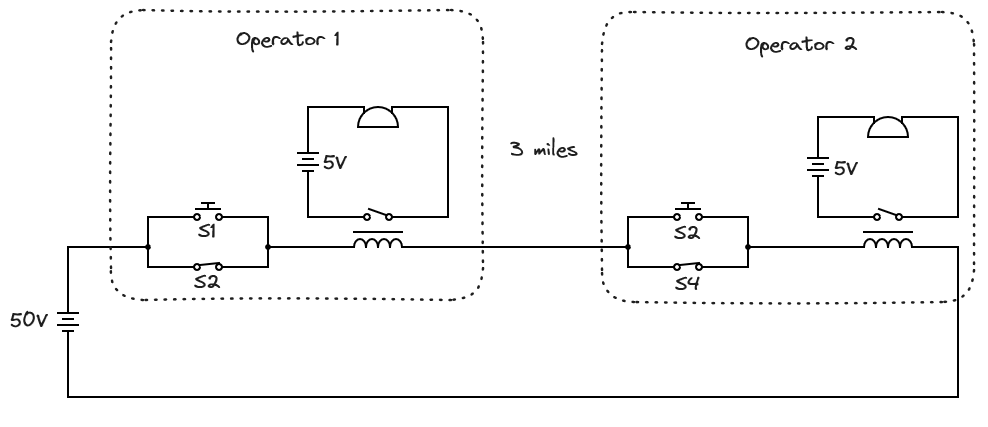
Notice that both S2 and S4 are normally closed, and the line is powered up. When operator 1 wants to send a message, they enable their key by opening S2. Now the line is powered off because the circuit is broken. Operator 2 will notice this because the metal armature that was resting against his bell will now move. Now operator 1 can send his message by pressing S1 in a pattern that rings the bell for operator 2. When he’s done, he closes the S2 switch and the line is active again. Now operator 2 can send a message back by opening his S4 switch and sending a message via his S3 key, ringing Operator 1’s bell.
The original Morse system didn’t rely on sound, but on writing. Instead of a bell the receiver was a device called a register. It used a clock-like mechanism to feed a paper tape under a pen. An electromagnet would push the pen against the paper when the key was pressed and lift up when it was released. This paper would then contain the dots and dashes sent as the message and could be read and transcribed into actual writing by the receiving operator.
In practice, telegraph operators quickly learned to distinguish the click-clack sound of the register engaging and could transcribe a message just from the sound. By 1860 most telegraph stations replaced their registers with a device called a sounder, which was like a bell but instead of a ringing sound the armature bar struck a metal bar making the click-clack sound that the operators had become accustomed to. The sounder had screws to adjust the distance of the armature and bar so both the volume and pitch could be adjusted. But how did these click-clacks get turned into words?
The Code
Morse code was designed to be very efficient and uses only two symbols (or sounds) to allow sending with a single key. A short sound is represented by a dot, while a longer sound (twice as long) is represented as a dash. Spaces between words are longer pauses (equivalent to three dots). Combinations of dots and dashes are used to represent letters. It’s a variable-length encoding scheme, so some letters only require a single symbol, others two, others three, etc.
Before the patent was filed in 1838 Andrew Vale visited local print shops to determine the frequency of various letters. The most common letters get the shortest number of symbols. For example E is the most common letter and is represented by a single dot. T is next and is represented by a single dash. The next four are A, O, I, and N, which each have two symbols, but O is kind of cheating. It’s not just a combination of dots and dashes but is two dots separated by pauses, shorter pauses than full spaces. This is a shortcut and takes advantage of timing. The time-length of the O is actually four dots long, but only the first and last dots are keyed.
This original coding scheme took advantage of several of these kinds of shortcuts using timing, making it irregular. These irregularities made the execution somewhat faster, but also more difficult to learn and easier to make mistakes. The table below shows the original patterns, not in alphabetical order but in character frequency order. The last column indicates which letters used timing shortcuts. There were also codes for numbers and punctuation which aren’t shown.
| Letter | Morse code | Shortcut |
|---|---|---|
| E | . | |
| T | - | |
| A | . - | |
| O | . . | X |
| I | . . | |
| N | - . | |
| S | . . . | |
| H | . . . . | |
| R | . . . | X |
| D | - . . | |
| L | ———— | Long dash |
| C | . . . | X |
| U | . . - | |
| M | - - | |
| W | . - - | |
| F | . - . | |
| G | _ _ . | |
| Y | . . . . | X |
| P | . . . . . | |
| B | _ . . . | |
| V | . . . _ | |
| K | _ . _ | |
| J | _ . _ . | |
| X | . _ . . | |
| Q | . . _ . | |
| Z | . . . . | X |
This system could be used to send messages at the rate of between 20-30 words per minute (wpm). To put that in context, an average English speaker can produce 150 wpm, an average typist 90 wpm and an average cursive writer 20-30 wpm. Learning and becoming proficient at this system took 1-2 years of practice.
The Railway
In 1844 the Morse Telegraph was demonstrated before members of Congress connecting two stations, one in Washington DC and the other in Baltimore 44 miles away. It was a success. By the end of 1846 there were six telegraph companies and many lines going from places like Baltimore to Philadelphia and New York, New York to Boston, and New York to Albany, Rochester and Buffalo. By 1856 the major cities in the Eastern US and Canada were connected, including a line from New Orleans to Washington DC, to Texas, Missouri, Toronto and Quebec. There were even separate lines in California, and a stand-alone line from Oregon City to Portland.
The principal driver for the telegraph wasn’t initially the public. The reason it grew so quickly was because of the railroads. The 1840’s was the decade the first railway companies began building rail lines between cities. Coordinating these trains, and dealing with mechanical and scheduling problems was nearly impossible without a way to communicate quickly. So many of the telegraph lines were strung on poles that ran along railroad tracks. Like rail stations, telegraph stations were placed in towns along these lines. It was the rapid experience and use of the telegraph by the railroads that led to rapid improvements to the telegraph.
From the very beginning the telegraph distances were pushed farther and farther as the rail lines grew. Two changes were made that extended this range. First, rather than have a stack of batteries at one end of the line, there was another stack at the other end, essentially putting both stacks in series with a long return line. Even this long return line was eliminated by using Earth Ground, essentially using the Earth as the return conductor. This meant each telegraph line only needed a single wire strung along poles from each terminal station on either end, which greatly reduced the cost.
Each line was called a main line and the stations at either end were called terminal stations. These terminal stations had the large primary battery stacks. Stations in-between were intermediary stations and they had much smaller local battery stacks for the local instruments (sounders/registers).
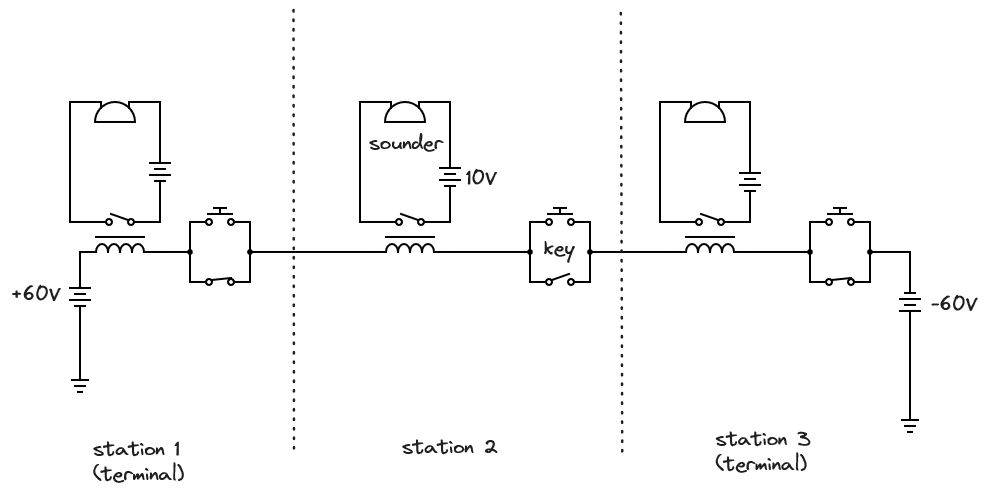
Station 1 is a terminal with a 60V battery stack. Notice that the negative battery terminal is connected directly to ground. Station 3 is the other terminal, also with a 60V battery but its positive battery terminal is connected to ground. The effective resistance from these ground connections is very low, effectively putting these battery stacks in series. The voltage across the main line is then 120V. The coils on the mainline needed about 50mA to operate the relays, so these battery stacks could support a main line resistance of 2400KΩ. The main line was No. 8 iron wire with a resistance between 10 and 20 ohms per mile, which means this mainline could be between 120 and 240 miles apart.
Station 2 is an intermediary station with only a small battery stack for local instruments. There could be an arbitrary number of these intermediary stations on a line, usually one in each town between the terminals. But only one station on the line could send at a time. Every station on the line would receive the message being sent, though the message was typically addressed to a particular station. This is very similar to how Ethernet would be designed more than 100 years later.
Networks
Any station on a mainline could send a message to any other station on that line. But what if you needed to send a message to a station on another line? Stations, particularly in busy towns, often had connections to more than one line. These stations could receive a message on one line, and then send it on another line. The operator would write down the message he received, then key it in again on another line. These interconnected mainlines formed a network of stations that allowed communicating from virtually any town to any other, though the routes may get fairly complicated.
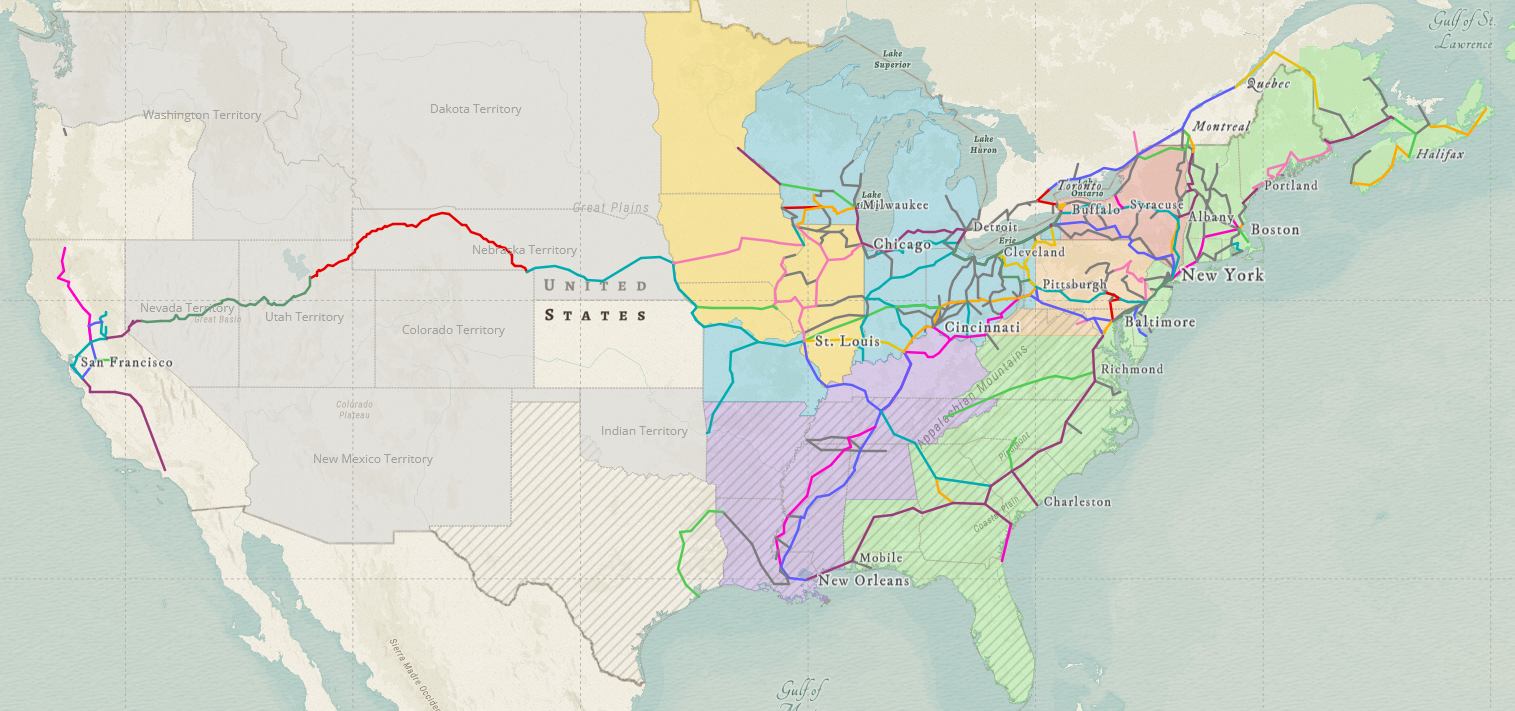
Edmund Russell and Lauren Winkler, “Uniting the States with Telegraphs, 1844-1862,” Carnegie Mellon University Libraries, https://telegraph.library.cmu.edu/
In 1861 the Telegraph stretched across the country connecting California to the East. While the Pony Express could deliver messages in about a month, messages by Telegraph could be relayed the same day.
Switchboards
Every station had at least one desk where the instruments were set up. On the wall was a board where the lines came in and were screwed to terminals. This board had a rail with brass pegs to connect the line to different screw terminals. Some of these went to the key for sending messages, another straight to ground, and if there were multiple main lines coming into the station they could be connected through these pegs. The board was called a switchboard because it allowed switching the connections between circuits quickly by moving pegs. This idea would carry on with telephone circuits and even early ways of programming computers.
International Morse
In 1848 the Morse system was demonstrated in Germany for use between Hamburg and Cuxhaven. This was the first use of the Morse system in Europe. The Inspector of the telegraph, a man named Friedrich Clemens Gerke, saw the challenges of the irregularities in the original code and modified it so that all letters were represented only by combinations of dots and dashes. The dashes were extended to be three dot counts instead of two, and the spaces between letters were seven dot counts. Each letter is then represented by one, two, three or four symbols. Since there are only two symbols, this structure can be represented as a binary tree, where going on a left branch represents a dot, and going on a right branch represents a dash.
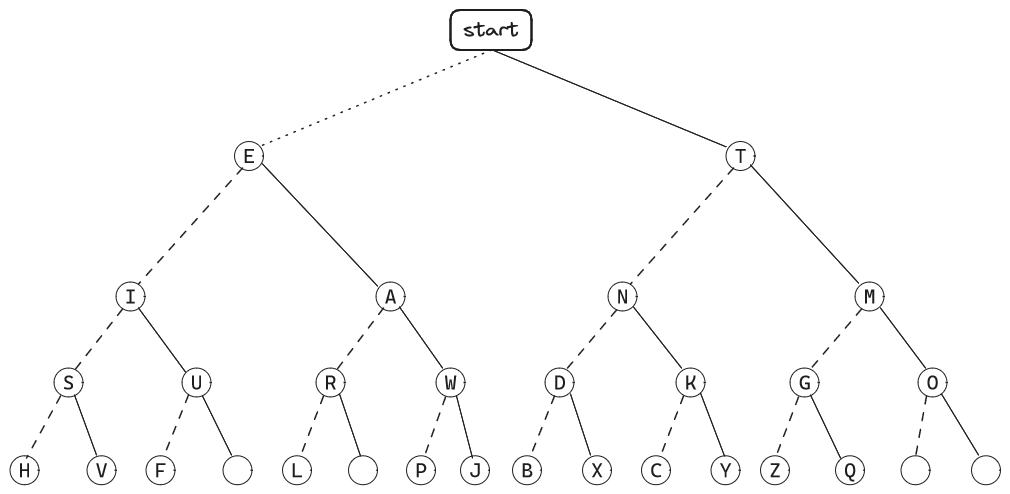
This system was known initially as Continental Morse to distinguish is from American Morse. By 1865 it was being used all over Europe and became known as International Morse. It was 5-20% slower than American Morse, but it was easier to learn and produced fewer mistakes. It became the standard for international telegraphy and eventually completely replaced the American version.
There were several attempts at connecting the US to Europe but the first reliable transatlantic Telegraph cables came in 1865. There have been permanent cables connecting the continents ever since.
Telecommunications
When I was a kid I remember making long distance phone calls was a big deal. They were expensive, and you had to plan on when to reserve time to make them. Today we can send messages anywhere without even thinking about it. All of this began with the Telegraph. Many of the ideas behind it have contributed directly and indirectly to how we think about switching circuits, networks and encoding data. Even the protocols that were devised between operators to communicate resemble protocols that would later be implemented in software. In many ways the way we think about the world and how we live in it today can be traced back to the Telegraph.